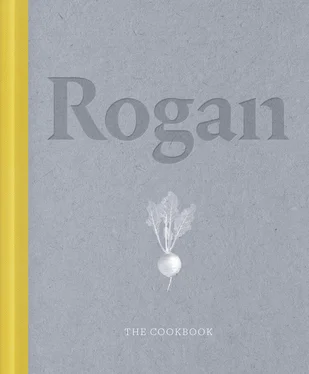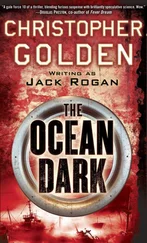My passion for cooking began as a child, and by my teens I was working in the kitchens of some of the best restaurants in the world for the finest, most inspirational chefs. I was lucky to get such a fantastic training, but the basis of my cooking is not just about the combination of flavours, textures and colours on the plate; what matters most is the origins of the foods I am using. While working in other chefs’ kitchens I always knew that what I really wanted was to cook my way, using the freshest, most seasonal ingredients that I could find, whose provenance I knew.
Opening my own restaurant was, of course, my ultimate goal, but for me the vision didn’t end there. With taste and flavour at the forefront of my mind, my main aim then, as it is now, was to have a restaurant that used foodstuffs from its own world-leading, natural and sustainable growing operation. What I’d been dreaming of for so long was an organic farm designed by chefs, run by chefs for chefs.
My food philosophy has always been about connecting the restaurant and the food we serve to the local area and the seasons, but this also goes deeper. I believe, whether we are cooking at home or in a professional kitchen, we can’t truly understand our food if we don’t know where it has come from. The origins of our ingredients is crucial, not just for our enjoyment of it and our health, but also for the sake of our planet. We need to do more to protect the Earth; we are on the verge of a climate disaster and if we don’t make changes fast, gastronomy will not be sustainable, and may not even exist as we know it today. It’s not all doom and gloom, though; rather than be overwhelmed by anxiety over climate change, we should see this as the time to adopt a new approach, to create a positive future for the generations to come.
The way we eat now has shifted more in the last five years than in the last 10,000; we were once such simple creatures, working with the seasons and taking only what we needed from the land, but with the quest for cheap food and high profits we have created a world where any ingredient is available all of the time.
In the supermarkets, there are no seasons – you can buy tomatoes year round which are grown on the other side of the world, picked when green and ripened using ethylene gas. What you get looks like a tomato, but really it is just an idea of a tomato, lacking the flavours, textures and colours of the home-grown product.
This isn’t only true of the foods that are imported from around the globe; the majority of non-organic locally sourced vegetables you find in supermarkets are grown ‘conventionally’ – meaning they have been sprayed with seriously dangerous, toxic chemicals to ensure ‘perfect’ blemish-free crops and high yields. Chemical pesticides, herbicides and fertilisers are big business, and many farmers are wholly reliant on them. Thus the majority of commercial vegetables are actually bad for our health. To me, this just isn’t right.
This food revolution shouldn’t just be confined to fruit and vegetables, it is also relevant to the vitally important question of how we rear livestock. Fundamentally, although I do eat meat and would never call myself a vegetarian, I think we should eat less meat and try to change our mindsets so that meat and fish don’t dominate the plate. I cook meat in the restaurants, but often only as the protein element of a dish, which plays a supporting role to fresh vegetables and herbs.

I’m not anti-animal husbandry per se, but the commercial farming of livestock has a huge impact on both the environment and the health and happiness of the animals themselves, which in turn has an effect on the flavour of the meat produced. Most of the processed foods that we consume every single day have a connection to chemically produced corn, wheat and soy bean fields, and these three commodities are also fed en masse to the world’s cattle population.
Cows are not designed to eat these products, they are designed to eat grass and forage from woodlands, but instead they are pumped full of dangerous grains to fatten and finish them very quickly, then topped up with hormones and antibiotics to cope with the stress of such an unnatural diet. We are effectively producing meat that is damaging to our health.
Feeding these animals in this way has a very clear impact on the planet, as a staggering 45 per cent of the world’s land mass has been cleared for animal agriculture and to cultivate the grains to feed them. Producing meat and dairy products also puts pressure on water supplies – animals consume 30 per cent of the world’s water (humans consume 19.6 billion litres of water and 9.5 billion kg of food per day, cows 170.3 billion litres of water and 61.3 billion kg of food per day) and are fed water-intensive grains. In addition, waste and fertiliser run-off is the leading cause of water pollution and ocean dead zones, destroying habitats and causing species extinction on land and in waterways.
And the impact of commercially rearing livestock doesn’t end there. Raising cattle in intensive systems produces more greenhouse gases than the world’s transportation system combined. Livestock produce methane, which is 86 times more destructive than carbon dioxide emissions from vehicles. Animal agriculture produces both of these gases, along with nitrous oxide, which accounts for 51 per cent of ‘human-caused’ climate change.
To me, none of this makes sense. Nature provides such abundance when it is nurtured and respected, and in these days of overconsumption on a global scale, I believe we need to step back and appreciate what our local area offers us. And now is the time to make those major changes that are needed within our food system.
This wider environmental context was, and still is, very much a part of my vision and approach to food. As with everything we cook, I need to know that it has been produced in an environmentally sensitive way. If we purchase ingredients from outside of the farm, I want to know their history, and that they have been produced in a sustainable, organic way.
So, at the start of the new millenium, frustrated at the way in which I was cooking, I started to actively search for suitable premises to open up my own restaurant. Originally I looked in the area around my home on the south coast, but after months of searching and visiting sites, I drew a blank – nothing was quite right. Then, suddenly, I got a phone call from an old friend, telling me about a site … in a village in Cumbria. Once I’d worked out where Cartmel actually was, and got my head round the fact that it was hundreds of miles from where I’d envisaged being based, I agreed to take a look.
Having been lured up north by the promise of an 800-year-old former smithy in a picturesque Cumbrian village, I left the south coast on a wet Friday morning and arrived at Cartmel that afternoon. The building, in the process of being converted into a restaurant, was tucked away in the corner of a sleepy, twelfth-century village famed for its medieval priory, the smallest horse-racing track in Britain and sticky toffee pudding, set amongst the rolling hills and valleys of the Lake District. Although it was in the process of renovation, I could see its potential. I had been sold a vision – and I bought it. Here was a restaurant that could be everything I dreamed of.
The original idea behind the restaurant, of course, was to be able to cultivate our own fruits and vegetables, so that we could then get these delicious, lovingly nurtured products from farm to plate in minutes, fresh from our own organic soil, rather than be dependent on suppliers shipping in produce from distant shores or across the length of the country.
Читать дальше













